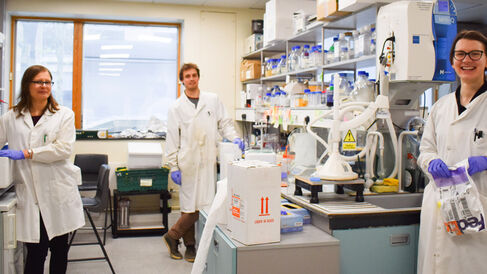Targeting conserved RNA elements in SARS-CoV-2 for therapy

Targeting conserved RNA elements in SARS-CoV-2 for therapy.
The Luisi Group and a large team of international collaborators are working to develop drugs against the SARS-CoV-2 virus behind the COVID-19 pandemic. The virus stores its genetic information in the form of an RNA molecule. Unlike human DNA, which exists in the form of a rigid double helix, the viral RNA is a flexible single-stranded molecule that can fold upon itself and can form many different structures along its length. Some of these structural elements are highly conserved among related viruses, indicating that they may play an important role in survival and proliferation. The structure of one such element, the s2m, has been determined experimentally for the very closely related SARS-CoV-1 virus. It is likely that the highly-structured, highly-conserved s2m element is needed for key functions that underlie viral genome replication and production of new virus particles. Our hypothesis is that blocking or destroying this element might inhibit proliferation of the virus. Therefore, our aim is to develop anti-viral agents targeting s2m, in the hope that these could lead to new therapies for patients.
We have been working to explore our hypothesis experimentally. First, we used chemical probing to confirm the structure of the s2m element from the current SARS-CoV-2 virus. We then designed and tested LNA gapmers that target the s2m element. LNA gapmers are high-affinity nuclease-resistant antisense nucleotides (ASOs) that drive target RNA degradation through recruitment of endogenous enzyme (RNase H) in cells. Due to its high sequence conservation and a possible role of the structural element in the viral life cycle, s2m is an attractive target for ASO-based therapy, with potentially only slow emergence of resistance and broad applicability across beta-coronaviruses. The LNA-based gapmers designed against the s2m element successfully silence the RNA in cell reporter assays and in viral replicon test systems. The designs are currently being further optimised to reduce toxicity due to off-target effects.
In parallel with these efforts, we are using structural and computational approaches to find inhibitors of the viral polymerase. We have identified a potent inhibitor from a repurposed drug used in the clinic. To further test the activity of the potential new drugs and ASOs, we will be introducing them alone and in combination to cells infected with SARS-CoV-2, where a reduction in viral proliferation would be a hopeful indicator of effectiveness. We will share all relevant results as soon as we have confirmed them, so that other researchers around the world can build on our findings and help advance development of new anti-viral therapies.
Publications
Lulla V, Wandel MP, Bandyra KJ, Dendooven T, Yang X, Doyle N, Oerum S, O'Rourke S, Randow F, Maier HJ, Scott W, Ding Y, Firth AE, Bloznelyte K, Luisi BF (2020). Antisense oligonucleotides target a nearly invariant structural element from the SARS-CoV-2 genome and drive RNA degradation. bioRxiv. doi: 10.1101/2020.09.18.304139 [preprint]
